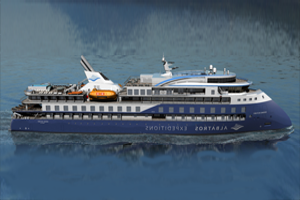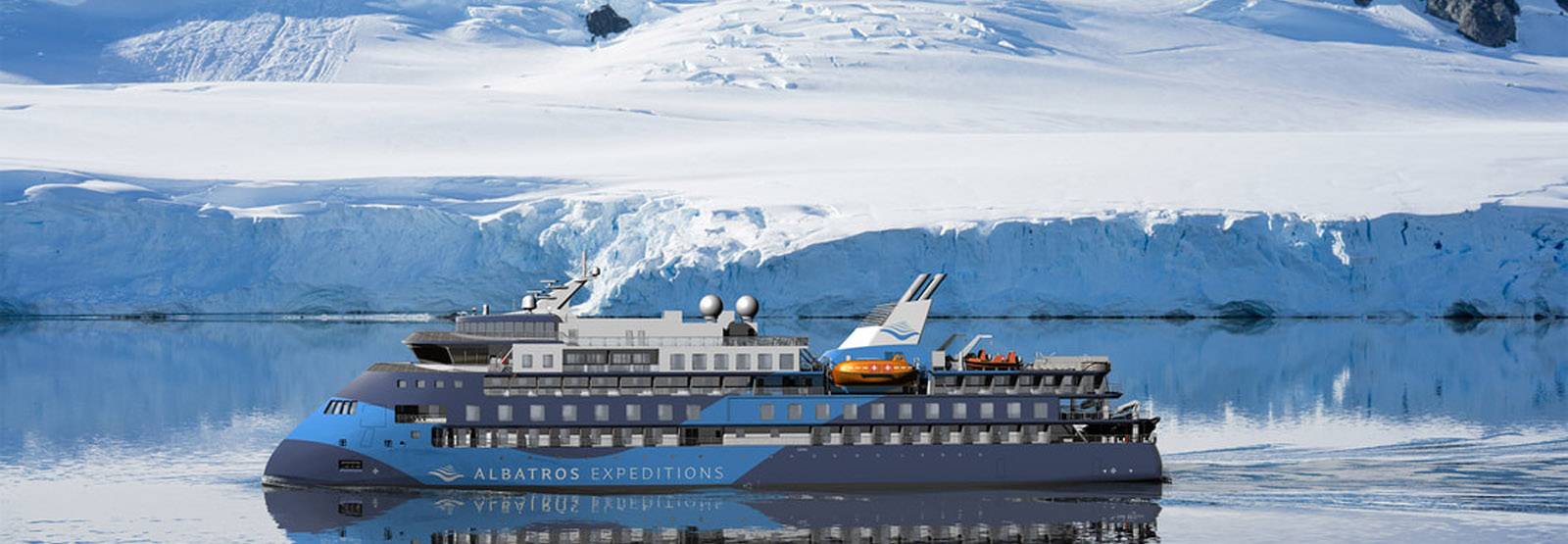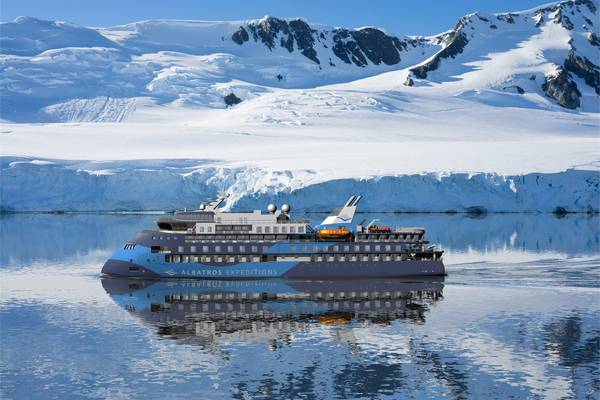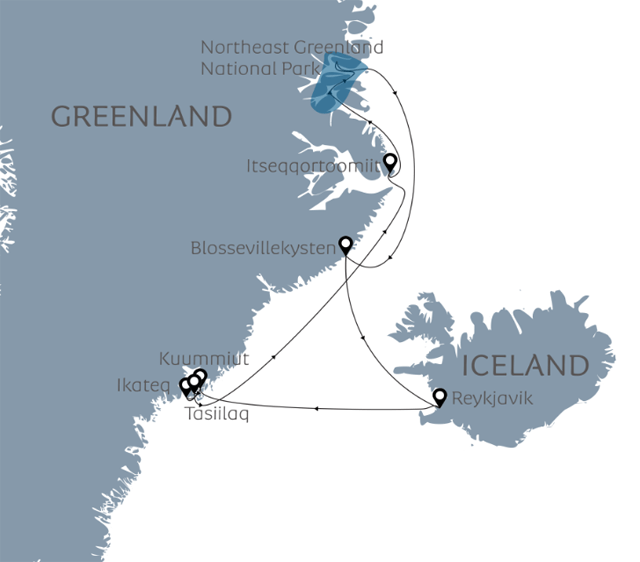HIGHLIGHTS
Discover one of the world's most beautiful, wild and pristine natural areas in the huge North Greenland National Park. On this unique Albatros expedition cruise, we will venture far from the usual tourist routes and visit places where only true expeditioners and scientists travel. Here we will experience unspoilt Arctic landscapes with good chances of seeing polar bears, whales and musk oxen.
DATES / RATES
Rates are listed per person in USD. Promotional offers are not reflected in the rates below.
|
| Start Date | End Date | Category F | Category G | Category E | Category D | Category C | Category C SP | Category C XL | Category B | Category A | Polar Premium Suite | Polar Family Suite |
|---|
Rates are listed per person in USD. Promotional offers are not reflected in the rates below.
|
| Start Date | End Date | (Starting from)
Category F | (Mid-range)
Category C SP | (High-end)
Polar Family Suite |
|---|
ITINERARY
DAY
1: REYKJAVÍK, ICELAND
The
rock-like columns of Hallgrímskirkja Church loom over the
city of Reykjavík, a hip Scandi capital which needs little
introduction. With new Nordic cuisine, excellent shopping, fantastic
excursions and an easy relaxed vibe, Reykjavík is one of
Scandinavia's most welcoming and exciting cities.
In
the afternoon, we await to welcome our guests onboard Ocean Albatros.
After our mandatory safety drill, enjoy dinner and a glass of champagne
as we set sail a course for adventure as we set out across the Denmark
Strait, bound for Greenland.
DAY
2: AT SEA, CROSSING THE DENMARK STRAIT
The
Denmark Strait is the narrow section of the North Atlantic separating
Iceland from Greenland. This body of water is among the most productive
in the world, where the cold polar East Greenland Current collides with
the warm northbound Gulf Stream. These nutrient-rich waters support
vast stocks of fish, and the humans, seals, whales and seabirds which
rely on them.
Days
at sea are never dull. We will arrange a variety of activities onboard
for our guests to enjoy to engage the mind, body and soul. Join your
knowledgeable Expedition Team lecturers in the Theatre to hear
specially-crafted lectures on Greenlandic history, wildlife, geology,
culture and more, unwind with a massage in the Albatros Polar Spa, or
simply watch the seabirds gliding along the ship from our hot tubs as
the Ocean Albatros flies across the Denmark Strait.
DAY
3: KUUMMIUT AND IKATEQ
We
will spend the morning in the small village of Kuummiut, which sits in
breathtaking surroundings in the calm reaches of Ammassalik Fjord.
Kuummiut - meaning 'People who Live by the River' - is one of the
larger villages in the area, and one of the most prosperous. Sitting
upon some of East Greenland's richest fishing grounds, Kuummiut holds
the only fish factory in the region, and fishermen from miles around
come through Ammassalik Fjord (which is wide enough to stay mostly
ice-free year-round) to sell their catch here.
Kuummiut
is an ideal place to experience life in an East Greenlandic settlement.
Where other towns have traffic, Kuummiut has the yowling of sled dogs
and the sigh of the wind through the grass. No roads lead in or out of
this isolated village, and the sea is the highway for local transport -
although motorboats have replaced the skin boats which brought people
to these shores long ago. It is a perfect place to simply sit, watch
the icebergs pass, and perhaps see the whales which often frolic in the
calm waters offshore.
In
the afternoon, we will sail slightly eastward from Kuummiut to Ikateq,
a spectacular fjord with a fascinating history. During the darkest days
of the Second World War, American forces established an airbase here
(one of the network of air bases which includes Kangerlussuaq on the
west coast) to serve as a stepping stone for aircraft transiting
between Europe and North America. The rugged landscape of East
Greenland meant the approach into the airport was hazardous, with
frequent fog masking the treacherous mountains. Huge recources were
invested into Ikateq Airbase (also known as Bluie 2 East), with a
5,000ft runway, hangar, barracks and port constructed. A fleet of
military vehicles and thousands of barrels of fuel were also brought to
this remote region. With Germany defeated, improvements to
intercontinental aircraft, and increasing tensions with the Soviet
Union, the United States Military abandoned the base in 1947, leaving
almost everything behind.
The
air base has been a bone of contention between Nuuk, Copenhagen and
Washington for many years. Many in the Greenlandic government wanted
the site cleaned up and the ruins removed; an expensive and
logistically challenging task. Eventually, the Danish Government agreed
to remove hazardous waste from the site (mainly decaying fuel drums),
leaving the rest of the equipment in place as an important part of
regional history. Over 75 years later however, almost everything
remains as it was on the day the Americans left. Ikateq is a truly
unique place, a time warp to the Second World War: eerie, fascinating
and surrounded by staggering natural beauty.
DAYS
4: TASIILAQ
In
the morning we arrive in Tasiilaq, the largest settlement in East
Greenland. Unlike the west coast, which has had uninterrupted contact
with Europe since the 1700s, the coast of East Greenland remained more
or less uncontacted until around 1894, when a Danish trading post was
established at Tasiilaq. The vast distances involved in Arctic travel
meant that the people of East Greenland (Tunumiit) were isolated from
their cousins to the west, and the language, traditions and culture of
East Greenland therefore differ significantly to those in other parts
of the country.
Ancient
traditions are strong here. This region of Greenland was the home of
the last Angakkuit (Shamans) of Greenland, and is the home of the
tupilak - a monster fashioned from animal (and sometimes human) body
parts and animated by the power of an Angakkuq to wreak havoc on
enemies. Creating such a monster was dangerous, as it could be turned
back by a more powerful magic user to attack its creator. The first
Europeans were curious as to what these dark beasts looked like, and
locals carved facsimiles in bone or horn, beginning one of Greenland's
finest artistic traditions. The tupilaat made by artisans in Tasiilaq
are considered among the best in the country.
Tasiilaq
sits in a perfect natural harbour on Ammassalik Island (meaning 'the
Place of Many Capelin'). While superficially similar to towns on the
West Coast, visitors will quickly notice differences; the landscape
here is much more rugged, the people fewer, and the sled dogs much more
numerous. Tasiilaq offers excellent opportunities to explore, with
excellent hiking routes such as the Flower Valley easily accessible
from town. For those wishing to delve into Tunumiit culture, visit the
museum, located in the city's old church, hear the city's exquisite
choir perform in the modern church, or watch a drum dancer in
traditional East Greenlandic costume perform a millennia-old spiritual
tradition. For those wishing to indulge in some retail therapy, visit
the Stunk Artist's Workshop, where skilled craftsmen create beautiful
pieces from natural local materials.
DAY
5: AT SEA, EN ROUTE TO ITTOQQORTOORMIIT
Sailing
along the coastline of this vast island (where reaching the
next-closest town takes two nights and a day of sailing), it can be
difficult to comprehend the scale of this huge country.
Measuring
roughly four times the size of France, Greenland dominates the Atlantic
portion of the Arctic, covering latitudes from 59-83°N, and
11-74°W. Around 80% of Greenland is covered by the Greenland
Ice Sheet (known as Sermersuaq or 'The Great Ice' in Greenlandic), the
largest body of ice on earth outside Antarctica. The Greenland Ice
Sheet is so vast that it governs the weather patterns of the region,
with summer meltwater and winter ice largely driving ocean currents in
this part of the North Atlantic.
Despite
the lack of towns, the stretch of coastline between the Ammassalik and
Scorsesbysund region is of vital importance to the residents of the
area. During the summer, locals hunt whales, seals and other game by
boat along the coast of this vast wilderness, as their ancestors have
done since time immemorial. Some skilled hunters still choose to use
kayaks to sneak up on skittish prey like narwhals - continuing a
millennia-old hunting tradition. While some choose to use snowmobiles
in winter to traverse the sea ice which hugs the coast, most hunters
choose to use dogsleds, which are more reliable, rugged, and do not
rely on fuel. In this challenging country, ancestral traditions are
still superior to the trappings of modern life.
DAY
6: ITTOQQORTOORMIIT
Entering
Scoresbysund, Earth's largest and longest fjord system, one could be
forgiven for not realising this huge 35km inlet is a fjord at all!
Scoresbysund is named for English whaler and explorer William Scoresby,
one of the first Europeans to map this region; the local name for this
vast fjord system, Kangertittivaq, is a typical Greenlandic
understatement, roughly meaning 'The Rather Large Fjord'.
The
only settlement in this region is Ittoqqortoormiit (meaning 'the People
who Live in Big Houses), which surely ranks among the most remote
communities on Earth. As the name suggests, the town is relatively new,
having been established by Danish authorities in 1925. Colonists were
relocated from the Ammassalik region further south in response to what
were seen as poor living conditions in the area, as well to establish
Danish sovereignty in the region during a territorial dispute with
Norway. While the establishment of the town was challenging, the
settlers soon realised the region was hugely rich in game, with
excellent hunting and trapping opportunities. This tradition continues
to this day - the majority of residents continue to live a subsistence
hunting lifestyle, essential in a town where supply ships arrive only
once or twice each summer. The only access to the outside world is via
the heliport to the nearby airport, from where small aircraft depart
for Iceland.
Ittoqqortoormiit
is a town with a strong sense of community and traditional culture,
where foreigners are welcomed warmly. The town hosts an excellent
museum, a beautiful traditional Greenlandic church, and locals often
welcome visitors to their community wearing colourful traditional
costumes. The town represents a wonderful introduction to the culture
and lifestyle of Northeast Greenland, in one of the most spectacular
natural locations anywhere in the world.
DAY
7-9: NORTHEAST GREENLAND NATIONAL PARK
During
the night we cruise past the rugged peaks of the Liverpool Land
peninsula and reach the mouth of King Oscar Fjord. We are now in the
vast Northeast Greenland National Park; measuring almost a million
square kilometers (almost twice the size of France), this is the
largest National Park and the largest area of protected land on Earth
and includes the northernmost land on the planet.
There
are no permanent settlements in the area, but up to the middle of the
19th Century various nomadic Inuit hunters lived in this spectacular
region, harvesting the natural riches of the area.
The
program for our days in the National Park depends on wind, sea, weather
and ice conditions. In such a remote region so far north, Mother Nature
dictates all human activity. Our exact route and activities will be
determined by the Captain and the Expedition Leader jointly and are
typically announced the night before.
Some
of the interesting landings we may visit include the 1300-meter-high
rock wall Bastionen on the coast of Ella Island. Further north we may
pass pass the small Maria Island, where the Germans had a camp during
World War II. The Germans' attempt to gain a foothold in Greenland
during World War II is a fascinating story in itself. Past Ruth Island,
we hope to make a landing on Ymer Island at Blomsterbugten, a small
oasis in the national park. From the tiny hunting lodge Varghytten we
can enjoy the formidable view of the characteristic, flat mountain
Teufelsschloss, where the multicoloured rock layers testify to the
area's exciting geological development. From here, we may aim to sail
by the mighty iceberg-producing Waltershausen Glacier before entering
beautiful Moskusokse Fjord. On our way back towards open sea we might
aim for landings on Jameson Land, which is a breeding ground for polar
bears.
Wherever
we go in this vast wilderness, our guests can be sure of encountering
excitement, adventure, and mind-boggling natural beauty. Our
experienced Expedition Team will be on hand to provide guests with as
much knowledge of the region as possible; either in hand-crafted
lectures, evening recaps, onshore, or over a cup of coffee on
deck. Throughout our time in the National Park, our skilled
Expedition Team members will be constant lookout for the charismatic
wildlife of the region - keep your binoculars handy!
DAY
10: BLOSSEVILLE COAST
Possibly
the most dramatic coast outside of Antarctica, the Blosseville is
guarded by Greenland’s highest mountains and steepest fjords
– and a belt of pack ice which was once able to ward off
explorers, sometimes for years at a time!
The
Blosseville Coast is named for French Explorer Jules de Blosseville,
the first European to sight this formidable coastline. While attempting
to survey the coast in 1833 onboard the vessel La Lilloise, the vessel
and all onboard were lost without a trace. Subsequent expeditions
failed to find any trace of the vessel, and its fate remains a mystery
to this day.
The
recent decades have also had warmer summers and reduced sea ice cover,
which enables purpose-built ice-strengthened vessels such as the Ocean
Albatros to venture along the coast, on lookout for polar wildlife,
abandoned Inuit settlements and otherworldly landscapes.
DAY
11: AT SEA, EN ROUTE TO REYKJAVÍK, ICELAND
During
our time at sea approaching Reykjavik, a variety of activities will be
arranged on board to provide our guests with the chance to reflect on
their voyage. Relax with an expertly crafted cocktail in the Nordic Bar
in the company of new friends, soak up the knowledge and passion of our
Expedition Team during lectures, or simply enjoy the flight of the
fulmars which accompany us towards Iceland.
During
your last evening onboard, join the Captain and Officers for the
Farewell Cocktail Party, followed by a presentation of photos and video
by our onboard photographer - the ideal opportunity to re-live your
Arctic adventure. Skål!
DAY
12: REYKJAVÍK, ICELAND
As
the Icelandic capital comes into view on the horizon, strange objects
appear; trees larger than ankle height, glassy skyscrapers and streets
full of cars, busses and people... Such a bustling capital may feel
strange after the remote wilderness of Greenland!
After
a hearty breakfast, it is time to bid a fond farewell to the Crew and
Expedition Team of Ocean Albatros, and descend the gangway back to dry
land with memories of the voyage of a lifetime.
MV Ocean Albatros (Luxury Expedition, 184-guests)
With a total of 94 comfortable staterooms and suites, all with unobstructed sea view, most with their own balcony, the Ocean Albatros has definitely become one of the most popular expedition cruise vessels in the world. Like it's sistership the Ocean Victory it offers two restaurants, a wellness area, an Albatros Nordic Bar, an open deck dining facility, a modern lecture lounge, and other state-of-the-art amenities. The vessel has more than a 50% lower carbon footprint than traditional expedition vessels and is one of the most environmentally friendly, implementing the Green Initiative Program, ensuring both absolute comfort and sustainability for our guests. The Ocean Albatros also offers a unique panorama sauna, and even more dedicated solo travel cabins without a single-supplement.
 (Click image to view Ship details)
(Click image to view Ship details)
WHAT'S INCLUDED
- 12-day/11-night
cruise on Ocean Albatros in a shared outside double room with a private
bathroom in the category chosen
- English-speaking
expedition staff
- Guided
walks with the expedition team
- Nature
hikes and Zodiac cruises per itinerary
- Information
briefings and lectures by the expedition team
- Activities
in certain towns, as per itinerary
- Special
photo workshop
- Full
board on the ship
- Dinner
drink package
- Free
coffee, tea, and afternoon snacks on the ship
- Welcome
and farewell cocktails
- Taxes,
tariffs, and landing fees
- Digital
visual journal link after the voyage, including voyage log, gallery,
species list, and more
EXCLUSIONS
- Extra
excursions and activities not mentioned in the itinerary
- Single
room supplement and cabin upgrades
- Meals
not on board the ship
- Beverages
(other than coffee and tea and dinner-drink package)
- Tips
for the crew (we recommend USD 16 per person per day)
- Personal
expenses
- Transfers
to/from the ship in Reykjavik
- Travel,
cancellation, and senior insurance
- Anything
not mentioned under ’Inclusions’




